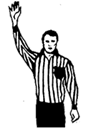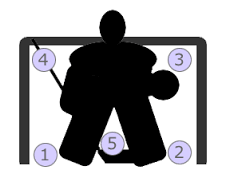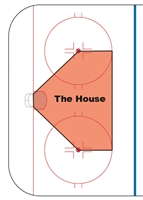In reading post camp evaluations, one thing that has been requested, is for us to define some of the terminology that we use both on the ice and in our chalk talks. This makes sense. While those of you that have been playing and/or watching the game for years may be familiar with most of these terms, the newbie player may be hearing them for the first time. Not understanding the language quite naturally impedes the learning process, and that is the last thing we want. Thus, we have created this dictionary of basic terminology. We will add new terms to the list periodically, as the need arises. Do you have a term you would like defined? E-mail rick@weekendwarriorshockey.com and we will do our best to define it and add it here.
To have a little fun with this, in addition to the basic terminology required, there are also quite a few fun slang terms used by hockey players. While these slang terms may not be crucial in learning how to be a better player, they certainly help one become more understanding of the hockey culture. The regular terms are in black, and the slang terms are in red.
Backchecking – The act of skating back to your defensive zone and applying pressure to opposing players when they have possession of the puck and are on the rush. We often joke “what is backchecking”, because adult league players are notorious for not being very motivated backcheckers. It should be noted that backchecking is NOT the act of checking someone in the back with your stick. That is known as cross checking, and is a penalty.
Bar Down – A shot that hits the bottom of the crossbar and goes right down into the net. Such a shot is normally responsible for an enormous grin by the shooter and for oohs and aahs from everyone else (except maybe the goalie).
Barn – A rink or arena. As in “They have to come play in our barn tonight.”
Beauty/Beautician – A player that is talented, both on and off the ice, and loved by his teammates.
Bender – Short for ankle bender, a derogatory term for a player who bends his ankles when skating.
Biscuit – The puck
Break out – When a team gains control of the puck in their defensive end they will “break out” with the puck to go on the attack. Most teams have established break out plays to accomplish this important part of the game.
Celly – A celebration after a goal is scored
Change on the fly – A team may change its players even as play continues. This is known as “changing on the fly.” A player coming on the rink cannot play the puck until the player they are replacing is off the rink.
Cherry Picker – A player who stays at center ice and does not help their team on defense. They hope to pick up a break out pass with no defenders in their way.
Chip – We normally use the term “chip” in the context of “chip off the boards”. This is where the puck is shot off the boards, normally up off the ice. The purpose could be to merely clear the puck out of the zone. More often it is a passing maneuver, where you are chipping the puck off the boards to a space where you expect your teammate to be able to get it. However, you can even chip it off the boards to yourself, as a means of getting around an opponent.
Chirp – Trash talk directed at an opponent, the opposing team’s bench, or the refs.
Cross-checking – This is a penalty that occurs when one player hits an opposing player forcefully with the shaft of their stick.
Cycling – Cycling is an offensive strategy used to keep control of the puck by keeping it close the boards. Offensive players make short passes to each other along the boards until they see an opening to pass to a teammate who is moving into the slot for a shot.
Deke (Deking) – A deke is used by an offensive player with the puck to confuse a defender or goalie. It is a fake or feint move. A common deke is to lower the shoulder in one direction but actually turn in the other.
 Delayed Penalty – A penalty that has not yet resulted in a stoppage of play because the team that will have the man advantage is in possession of the puck. Play continues until the team being penalized gains control of the puck. The referee will raise his arm indicating that there is a delayed penalty situation. The team with possession will send their goalie off the ice in exchange for another attacker, as it would be nearly impossible for the penalized team to score, as play will stop when the penalized team gets the puck. This essentially extends the length of time the non-penalized team has the man advantage. If a goal is scored before the play is stopped, then the penalty is waived off.
Delayed Penalty – A penalty that has not yet resulted in a stoppage of play because the team that will have the man advantage is in possession of the puck. Play continues until the team being penalized gains control of the puck. The referee will raise his arm indicating that there is a delayed penalty situation. The team with possession will send their goalie off the ice in exchange for another attacker, as it would be nearly impossible for the penalized team to score, as play will stop when the penalized team gets the puck. This essentially extends the length of time the non-penalized team has the man advantage. If a goal is scored before the play is stopped, then the penalty is waived off.
Dots – “The dots” is short for face-off dots, or the dots into which the referee drops the puck during a face off.
Dump and Chase – An offensive strategy used to get the puck over the opposing team’s blue line and into the corners where players can race to get it, thereby moving the play into the attacking zone.
Flow – Great hockey hair. Typically longer hair that “flows” out of the helmet. A young Jaromir Jagr sported some great flow.
 Five hole – The potential scoring areas around a goal are numbered from one to four starting in the lower right corner and proceeding clockwise at each corner of the net. The “5 hole” is between the goalie’s legs.
Five hole – The potential scoring areas around a goal are numbered from one to four starting in the lower right corner and proceeding clockwise at each corner of the net. The “5 hole” is between the goalie’s legs.
Forecheck – Checking, battling or applying pressure to the opponent in an attempt to retrieve the puck while in your offensive zone when the other team has possession. Forecheck is also a hockey slang term. In the slang term, the meaning is one of approaching a member of the opposite sex, typically while out at the bar, in an attempt to solicit a phone number or date. As in: “Where’s Joe?” “Oh, he’s up at the bar forechecking that entire bachelorette party.”
Game misconduct – A player is suspended for the remainder of the game if they receive a game misconduct. Their team continues to play at full strength unless a minor penalty is also assessed.
Gordie Howe Hat Trick – A Gordie Howe hat trick is a goal, an assist and a fight in a single game. Gordie Howe was both a prolific scorer, and a tough customer who was not afraid to drop the mitts.
Grinder – A player who makes up for a lack of talent by working hard and playing physical. A grinder normally plays on the 3rd or 4th lines, and will battle hard for the puck.
Grocery Stick – A player that sits on the bench the entire game between the forwards and the defensemen, acting like a separator you would use on the conveyor belt at the grocery store to separate your groceries from the next customer in line.
Guts of the Ice – This is simply the area of the ice between the dots, over the entire length of the ice. We typically use this term in the context of “defending the guts of the ice”. What we mean by that is that we want to keep attacking players from attacking our zone up the middle, or guts of the ice. Rather, we try to keep them “outside the dots”, meaning between the faceoff dots and the boards.
Hand Pass – The act of passing the puck using one’s hand. This is legal inside a team’s defensive zone, but illegal in the neutral zone and attacking zone, even if the pass originates from another zone.
Hash marks – Hash marks are small lines, which are perpendicular to the edge of the face off circles. Players cannot encroach on the hash mark areas during face-offs.
Hat Trick – When a player scores three goals in a game it is known as a hat trick. Three goals in a row is a “pure” hat trick.
Headman the puck – When a player passes to a teammate that is ahead of them on the attack this is headmanning the puck.
Hoser or Hose-head – A derogatory term. It is believed to have originated from the early days of hockey (before the invention of the Zamboni) when the losing team had to hose down the ice with water after the game.
 The House – “The House” is the area from the goal posts to the face off dots to the tops of the circles, and is best defined with a picture (see illustration at right). Defensively, we talk about “protecting the house”. This is because this is the area from which most goals are scored. Thus, we want to keep our opponents from having opportunities to shoot from inside the house.
The House – “The House” is the area from the goal posts to the face off dots to the tops of the circles, and is best defined with a picture (see illustration at right). Defensively, we talk about “protecting the house”. This is because this is the area from which most goals are scored. Thus, we want to keep our opponents from having opportunities to shoot from inside the house.
Icing – When a player shoots the puck from his side of the ice down past the center red line and goal line with no interference. Icing will result in a faceoff on the offending team’s side of the ice.
Interference – A two minute minor penalty will be imposed on a player who interferes with or impedes the progress of an opponent who is not in possession of the puck, or who deliberately knocks a stick out of an opponent’s hand or who prevents a player who has dropped his stick or any other piece of equipment from regaining possession of it.
Lettuce – A great head of hockey hair. See also flow, salad.
Long Change – In the second period, the goaltenders change ends, meaning that the players’ bench is closer to the offensive zone rather than the defensive zone. The “long change” can be a factor when a tired line is stuck in the defensive zone and cannot come off due to the increased distance to the bench.
Mitts – A player’s hands or gloves. Gordie Howe was known to have large mitts (hands), and he was not afraid to “drop the mitts” (fight).
Odd Man Rush – When the number of offensive players heading into the attacking zone is greater than the number of defenders, such as a 3-on-2 or a 2-on-1.
Offsides – An offsides is called when a player precedes the puck into the offensive zone as indicated by the blue line. When an offside occurs the referee stops play and the face off occurs outside the offensive zone.
Olympic Sheet – An NHL rink is 85′ x 200′. An Olympic rink (or sheet) is 100′ x 200′. International competitions are generally played on Olympic sheets. This additional 15′ of width can have a dramatic effect on opening up faster play.
Pinch – A pinch is when a defenseman either (a) attempts to hold the offensive blue line when the opponent has the puck and is attempting to clear their zone, or (b) leaves the blue line and pushes further into the offensive zone to play the puck. In both cases, the defenseman is making a gamble that he is going to win the puck battle, and thus improve his team’s chance of scoring. The risk is that he loses, and the other team goes on the attack with an odd man rush. It is considered a risky play, which requires good judgment. A defenseman who loses a lot of pinches can expect to be scolded by his coach and/or teammates.
Plumber – Similar to a Grinder. Not the most skilled player, but a hard worker who will battle in the corners and in front of the net.
Plus/Minus – When a goal is scored for a player’s team while the player is on the ice it is counted as +1. If a goal is scored against a player’s team while the player is one the ice it counted as -1. The total for the player is known as plus/minus. A high positive plus/minus number would be indicative of a player who is helping his team. The opposite is true for a player with a high negative plus/minus number. So even if a player scores a lot of goals, if his plus/minus is high negative, this is an indication that the player is not helping out defensively. Of course, there are other factors to be considered. This is just an indicator.
Point – The point is an area just inside the blue line of the attacking zone. It is normally occupied by the attacking team’s defensive players.
Sauce – Short for Saucer pass
Sacuer Pass – A pass in which the puck is passed to another player such that it flies in the air like a flying saucer. This makes the pass very difficult to intercept by opposing players but it will still land flat on the ice making it simple to control for the receiving player.
Salad – Beautiful hockey hair. See also flow, lettuce.
Scoring Chance – A scoring chance is defined as a clear play directed toward the opposing net from a dangerous scoring area – loosely defined as the top of the circle in and inside the faceoff dots, though sometimes slightly more generous than that depending on the amount of immediately-preceding puck movement or screens in front of the net. Blocked shots are generally not included but missed shots are. A player is awarded a scoring chance anytime he is on the ice and someone from either team has a chance to score. He is awarded a “chance for” if someone on his team has a chance to score and a “chance against” if the opposing team has a chance to score.
Screening – When a player on the opposing team obstructs the goalie’s view, it is called screening. If a player is obscuring the view of the puck or play occurring, it is more difficult for the goalie to block the shot.
Sieve – A really awful goalie that has a lot of holes through which to score.
Slot – A prime scoring area located between the faceoff circles and in front of the goal.
Strong Side/Weak Side – The strong side is the side of the ice where the puck (and most of the players) are located. The weak side is the other side. We speak of moving the puck from the strong side to the weak side of the ice to get away from pressure. Once the puck goes to the other side (and players follow), then that becomes the strong side.
Top Cheese/Top Cheddar – Used to describe a shot that scores in the top of the net, either off or just below the crossbar.
Twig – A hockey stick (even though very few are made from wood anymore)
Wave off – When a stoppage of play is about to occur, the referee may decide to continue play by “waving off” the stoppage. Examples include icing and offsides.
